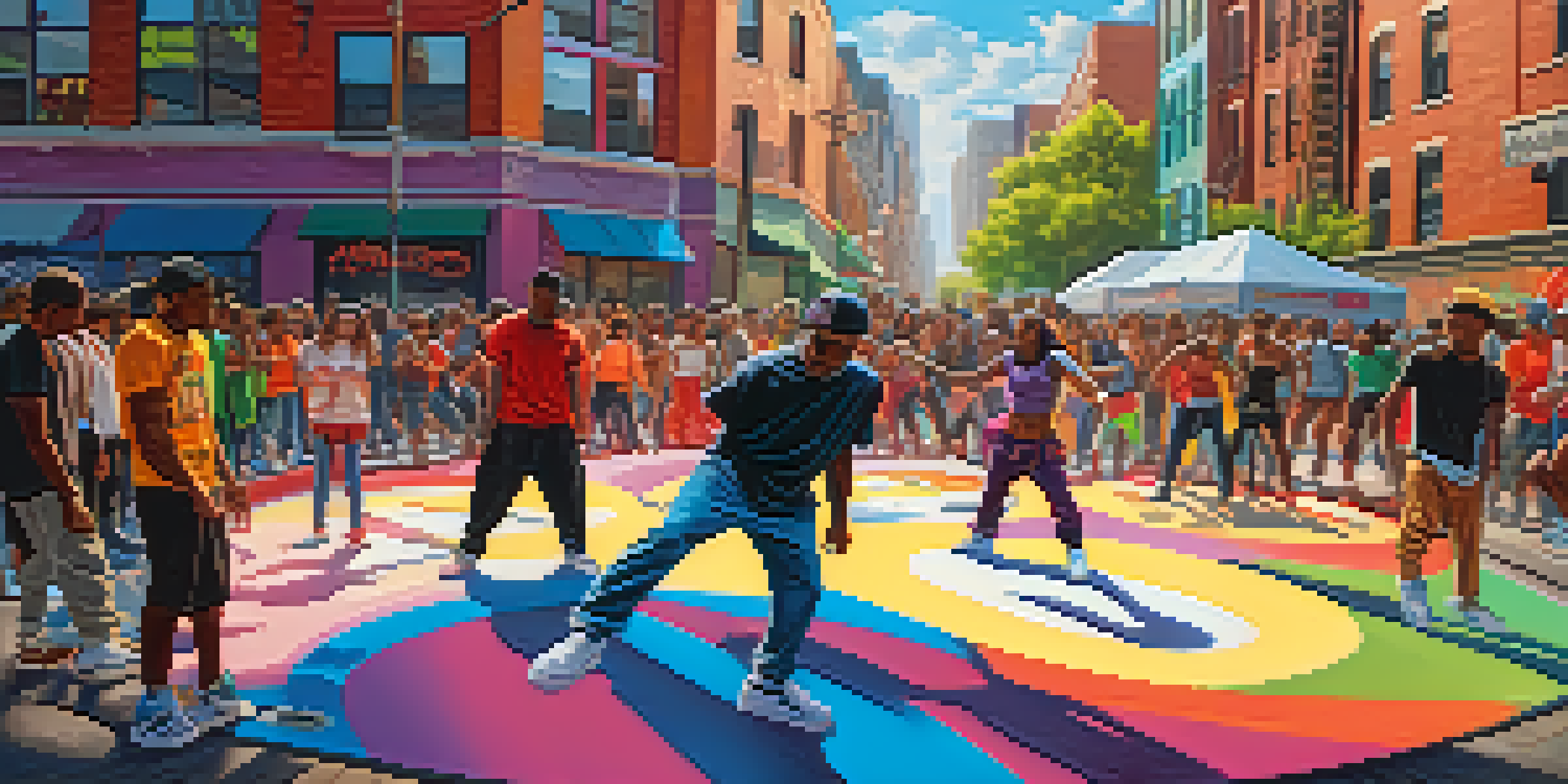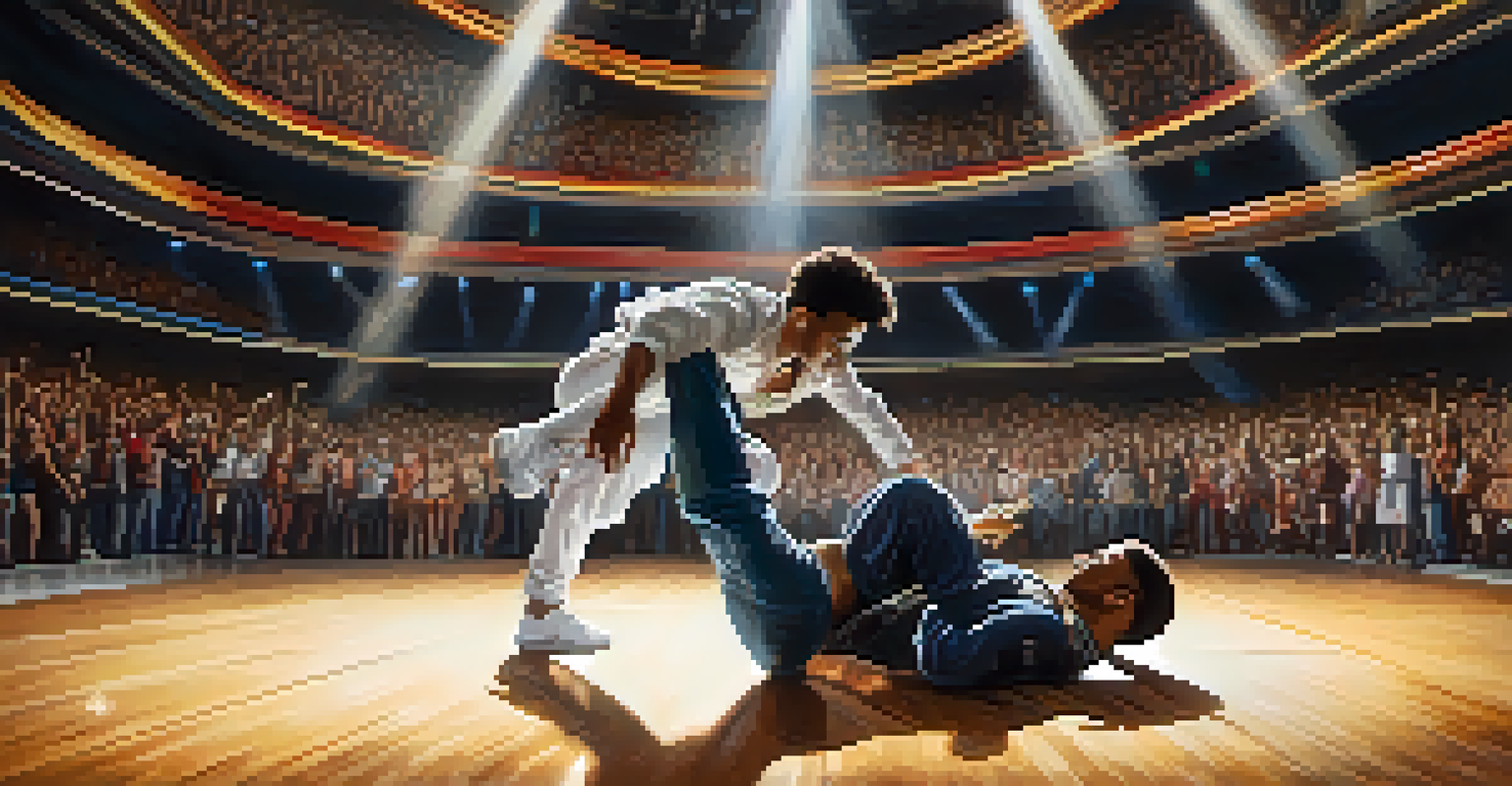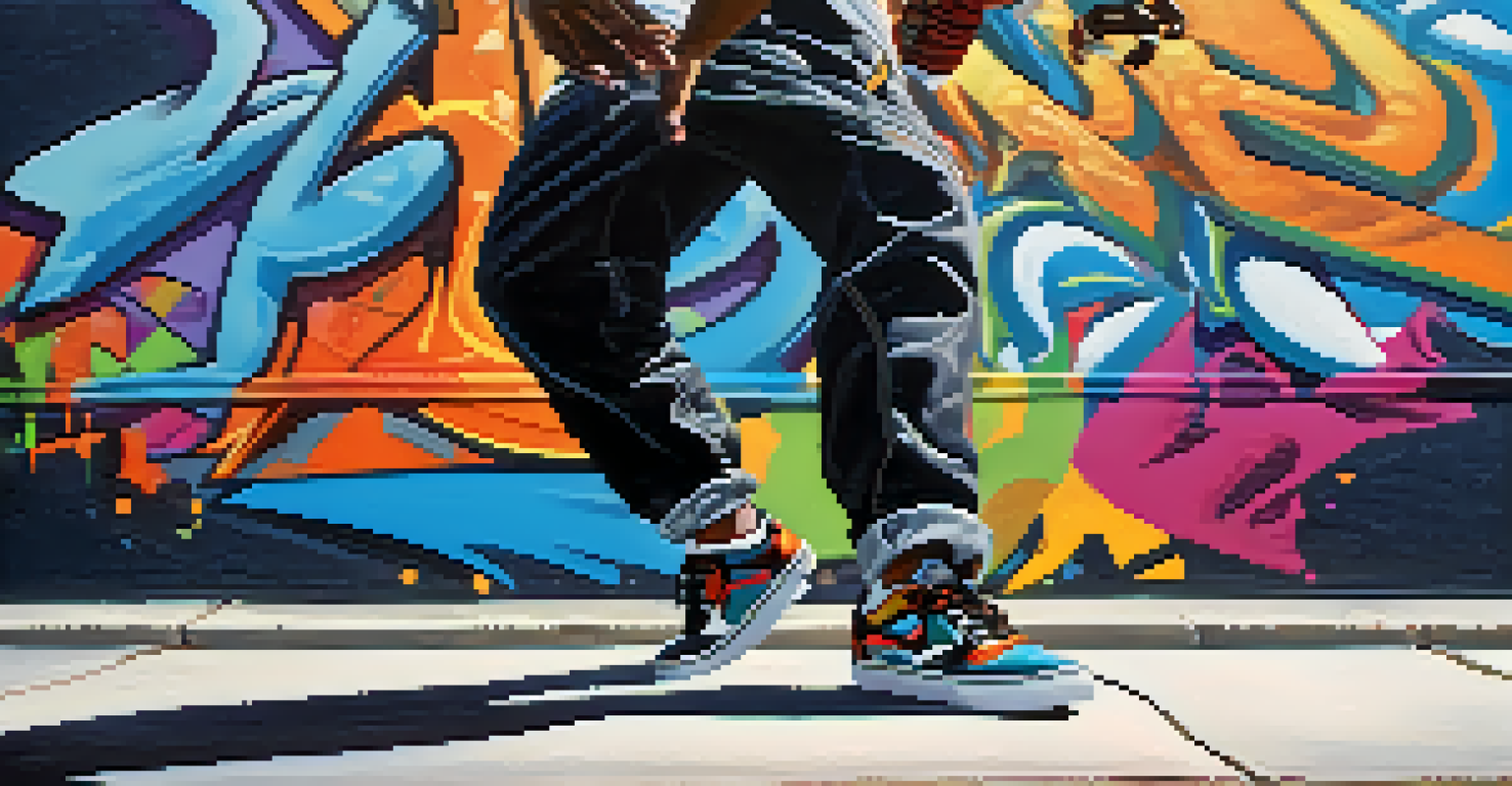Evolution of Breakdancing: From Streets to Stages

The Birth of Breakdancing: A Street Art Form
Breakdancing, or b-boying, emerged in the 1970s in the South Bronx, New York. It was a vibrant response to the cultural landscape, combining elements of dance, music, and art. As young people sought to express themselves, they turned to the streets, where the rhythm of hip-hop provided the perfect backdrop for their creativity.
Breakdancing is a way of life. It's about expressing who you are and where you come from.
This dance form quickly became synonymous with block parties, where dancers would showcase their skills in friendly competition. These gatherings fostered a sense of community and belonging, where everyone was encouraged to participate and celebrate their individuality. The raw energy of breakdancing captured the essence of hip-hop culture, making it a powerful outlet for self-expression.
As breakdancing gained popularity, it also attracted attention from the media. From documentaries to music videos, the dance began to reach audiences far beyond the Bronx, setting the stage for its future evolution. By the end of the decade, breakdancing was more than just a street art form; it had become a cultural phenomenon.
The Rise of Competitions: From Cyphers to Championships
As breakdancing grew in popularity, competitions started to emerge, offering dancers a platform to showcase their skills. These competitions, often held in cyphers – circular dance spaces – allowed b-boys and b-girls to challenge each other in a display of creativity and prowess. The competitive aspect added excitement and encouraged dancers to push their limits.

In the 1980s, events like the New York City Breakers and the Rock Steady Crew began to formalize the competitive scene. These competitions not only highlighted individual talent but also fostered camaraderie among dancers. As crews formed and rivalries developed, breakdancing transformed into a sport, complete with judges, scoring systems, and titles.
Breakdancing's Cultural Roots
Breakdancing emerged in the 1970s as a vibrant expression of creativity and community in the South Bronx.
The introduction of international battles further elevated the status of breakdancing. Dancers from around the world began to compete, creating a global community united by their love for the art form. This international exposure helped breakdancing evolve, incorporating diverse styles and movements from various cultures.
Mainstream Recognition: Breakdancing in Media
The 1980s and 1990s saw breakdancing gain significant mainstream recognition through movies and television. Films like 'Flashdance' and 'Beat Street' showcased breakdancing, introducing it to viewers who had never experienced it firsthand. This exposure helped elevate the dance form's status and drew in new dancers eager to learn the moves seen on screen.
Dance is the hidden language of the soul.
Television shows also played a vital role in popularizing breakdancing. Programs like 'Soul Train' featured live performances, allowing dancers to reach larger audiences and inspiring countless fans. These appearances solidified breakdancing’s place in popular culture, demonstrating that it was more than just a passing trend.
With its newfound fame, breakdancing began to influence other art forms, including fashion, music, and visual arts. This cross-pollination enriched the culture surrounding breakdancing, allowing it to evolve continually while retaining its roots. As the dance form gained traction, it became a symbol of creativity and resilience.
Global Expansion: Breakdancing Around the World
As breakdancing gained popularity in the United States, it began to spread globally. In the 1980s, dancers from Europe, Asia, and South America embraced the art form, each region adding its unique flair. This global expansion fostered a rich exchange of styles and techniques, allowing breakdancing to flourish in diverse cultural contexts.
Countries like France and South Korea became notable hubs for breakdancing, producing world-class dancers who would compete on international stages. Events such as the UK B-Boy Championships and the Battle of the Year showcased this global talent, drawing crowds and media attention. The vibrant international community of dancers helped to elevate breakdancing to new heights.
Global Growth and Recognition
The dance form expanded worldwide, leading to international competitions and its official recognition as an Olympic sport.
This worldwide embrace of breakdancing also led to the formation of international alliances and competitions, further uniting dancers across borders. The shared passion for the art form created bonds that transcended language and cultural differences, solidifying breakdancing as a universal expression of creativity and freedom.
The Role of Technology: Social Media and Online Tutorials
In recent years, technology has played a significant role in the evolution of breakdancing. Social media platforms like Instagram and TikTok have allowed dancers to share their moves and connect with others, fostering a sense of community. These platforms enable dancers to showcase their skills and gain recognition, often leading to opportunities that may not have been available before.
Additionally, online tutorials and dance challenges have democratized access to breakdancing. Anyone with an internet connection can learn the fundamentals, contributing to the growth of a new generation of dancers. This accessibility has broadened the audience for breakdancing, allowing it to flourish in unexpected places.
As a result, breakdancing is now more diverse than ever, with dancers from various backgrounds and experiences contributing to the art form. This technological shift has transformed the landscape of breakdancing, making it a dynamic and evolving practice that continues to inspire and unite people worldwide.
The Olympic Dream: Breakdancing's Official Recognition
In a landmark moment for the breakdancing community, the dance form was officially recognized as a sport by the International Olympic Committee (IOC) in 2020. Set to debut at the Paris 2024 Summer Olympics, this recognition marks a significant milestone in the journey of breakdancing. It highlights the evolution of the dance from its street origins to a respected competitive discipline.
This Olympic inclusion has sparked excitement and anticipation among dancers and fans alike. It offers a new platform for b-boys and b-girls to showcase their skills on a global stage, elevating the art form to unprecedented levels. The prospect of representing their countries and competing for medals adds a new layer of prestige to breakdancing.
Challenges in a Changing Landscape
As breakdancing evolves, maintaining authenticity amidst commercialization and trend pressures remains a crucial challenge.
However, this recognition also comes with challenges. As breakdancing enters the realm of formal competition, maintaining its authenticity and cultural roots becomes crucial. Dancers and the community must navigate this new landscape while preserving the essence of breakdancing that has inspired so many.
The Future of Breakdancing: Challenges and Opportunities
As breakdancing continues to evolve, it faces both challenges and opportunities. The proliferation of online content and social media can sometimes dilute the art form, as trends come and go quickly. Dancers must strive to stay true to their roots while embracing innovation and change, ensuring that breakdancing remains relevant in a fast-paced world.
Moreover, the rise of competitions and the Olympic inclusion can create pressure to conform to specific styles and standards. While this can offer recognition and legitimacy, it also risks overshadowing the grassroots nature of breakdancing. Balancing competitive success with authentic self-expression will be vital for the future of the dance form.

Ultimately, the future of breakdancing lies in the hands of its community. As long as dancers continue to innovate, collaborate, and inspire one another, breakdancing will thrive. Its journey from the streets to the stages exemplifies the power of creativity and resilience, ensuring that it remains an essential part of global culture for years to come.